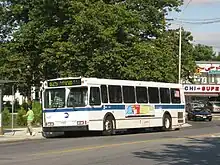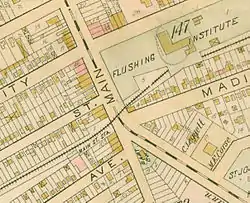Kissena Boulevard
Kissena Boulevard is a thoroughfare spanning the Flushing and Pomonok neighborhoods of the borough of Queens in New York City, extending from Main Street in the Flushing Chinatown to Parsons Boulevard in Kew Gardens Hills. The road's name is derived from Kissena Lake, a name given by 19th century horticulturist Samuel Bowne Parsons for the Chippewa word meaning, "it is cold". The lake is located in Kissena Park.
Kissena Blvd | |
|---|---|
 The Q25 bus traveling northbound on Kissena Boulevard in Kew Gardens Hills | |
| Owner | City of New York |
| Maintained by | NYCDOT |
| Length | 2.7 mi (4.3 km)[1] |
| Location | Queens, New York City |
| South end | Parsons Boulevard / 75th Avenue in Kew Gardens Hills |
| Major junctions | |
| North end | Main Street in Flushing |


The road is one of the oldest in Queens, a 4-mile path connecting the colonial settlements of Flushing and Jamaica, known originally as the "Road to Jamaica" and later Jamaica Avenue. After Queens was consolidated into the City of New York in 1898, the undeveloped sections of the borough were subdivided into a street grid. The section of the Road to Jamaica below 75th Avenue was absorbed into Parsons Boulevard and much of the north-south traffic between Flushing and Jamaica was taken by newly created Main Street. Kissena Boulevard serves as a diagonal route connecting Main Street with Parsons Boulevard. The boulevard is only 2 lanes wide for the majority of its run, but becomes 4 lanes wide with a median divider between the Long Island Expressway (LIE) and 71st Avenue. Additionally, Queens College borders the boulevard to the west, south of the LIE. A branch of the Queens Library is also on Kissena Boulevard. In the 2020s, Downtown Flushing is undergoing rapid gentrification by Chinese transnational entities.[2]
Transportation
Kissena Boulevard is covered by MTA Bus Company's Q25 and Q34 buses for its entire length.[3] The Q17 runs along Kissena Boulevard between Main Street and Long Island Expressway. Also, the Q27 runs along Kissena Boulevard between Main Street and Holly Avenue.[4] The Flushing–Main Street station of the Long Island Rail Road's Port Washington Branch is at the boulevard's northern end.
References
- Google (July 1, 2018). "Kissena Boulevard" (Map). Google Maps. Google. Retrieved July 1, 2018.
- Sarah Ngu (January 29, 2021). "'Not what it used to be': in New York, Flushing's Asian residents brace against gentrification". The Guardian US. Retrieved August 13, 2020.
The three developers have stressed in public hearings that they are not outsiders to Flushing, which is 69% Asian. 'They've been here, they live here, they work here, they've invested here,' said Ross Moskowitz, an attorney for the developers at a different public hearing in February...Tangram Tower, a luxury mixed-use development built by F&T. Last year, prices for two-bedroom apartments started at $1.15m...The influx of transnational capital and rise of luxury developments in Flushing has displaced longtime immigrant residents and small business owners, as well as disrupted its cultural and culinary landscape. These changes follow the familiar script of gentrification, but with a change of actors: it is Chinese American developers and wealthy Chinese immigrants who are gentrifying this working-class neighborhood, which is majority Chinese.
- MTA Regional Bus Operations. "Q25/Q34 bus schedule".
- MTA Regional Bus Operations. "Q17 bus schedule".